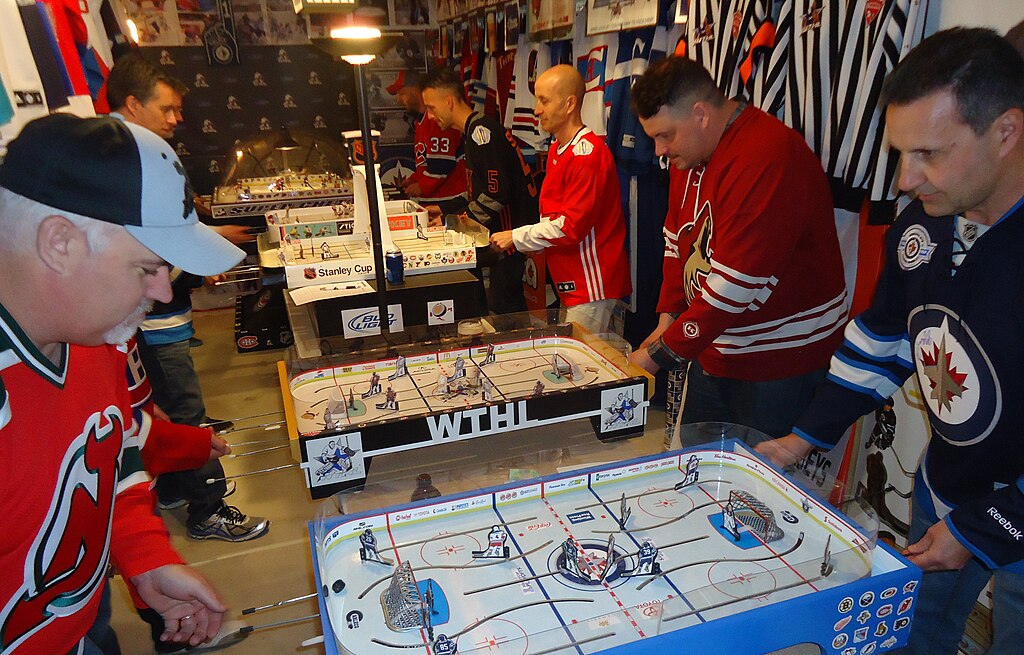Table hockey (also called rod hockey, board hockey, bubble hockey and stick hockey) is a tabletop toy that emulates the game of ice hockey. It is intended for two players, though it can accommodate more. Originally designed as a game for the children of its inventor, Donald H. Munro, table hockey has grown to become internationally popular. Though invented in Canada, it has become particularly popular in Sweden. There is also competitive league play with an international governing body, as well as professional table hockey tournaments with cash prizes.

Gameplay
Table hockey is designed to emulate the play of a conventional ice hockey game. Modern versions of table hockey typically feature a full set of five players per side, plus goaltenders. The miniature players are usually made of molded plastic and are controlled individually by metal rods that allow each miniature player to spin 360 degrees and to move the length of the playing surface in a straight line. Modern versions of the game allow the forwards to move deep into the opposition zone. The puck tends to be an oversized black plastic disk. The large size allows it to pass over the slots in the playing surface along which the players move.
Some versions of table hockey are played using a clock and a time limit (as in real hockey games), while others play until one player reaches a certain score. Like the sport of ice hockey, points are scored by using your players to shoot the puck into the opponent’s net.
Background History
Table hockey was invented by Donald H. Munro of Burlington, Ontario, in 1932. Munro was a Scottish-born owner of a fish and chips restaurant. He invented the game as a Christmas present for his children during the height of the Great Depression, as he had no money to buy gifts. Initially more akin to the game of “two-sided” pinball, Munro developed the game using materials he found around his home and built it by hand. The first game was made from clothespins, drawer knobs, butcher’s wire and spare wood. The playing surface was also raised in the middle and a marble was used as the puck. Munro enlisted the help of female relatives to sew hockey nets.
Though the game was popular with his family, Munro didn’t initially plan on mass producing or selling the game. That changed after a door-to-door salesman visited. Unable to buy his wares, the Munro family invited him for dinner. The salesman was impressed with the game, and suggested Munro take his invention to Eaton’s, the national chain of department stores that also had a successful mail-order catalogue. An Eaton’s purchaser ordered a game on sight, and then called Munro’s home to order several more. Retailing for $4.95 (more than $113 in 2024, adjusted for inflation), the game quickly became a national hit.
International Popularity
A competing Swedish table hockey design emerged in the mid-1950s. It features many of the design elements that are familiar today, such as individual control of the players, slots to allow players to move up and down the board, and the use of an oversized puck (rather than a marble or pinball). The Munro-designed game evolved and adapted to the Swedish design, along with chief rival, Eagle Toys of Montreal. Both companies competed aggressively with each other, incrementally innovating to gain an edge on the other.
The proliferation of television in the 1950s, which included broadcasts of professional hockey games (see also Hockey Night in Canada), opened up the American toy market. Table hockey increasingly included sponsorship agreements with professional hockey players, such as Bobby Orr, and featured the logos and colours of NHL teams. Unable to keep up with rapidly increasing demand for the games, both the Munro and Eagle versions were sold to larger American companies in 1968, within 24 hours of each other.
International Competition
The International Table Hockey Federation (ITHF) is the international body responsible for competitive table hockey. The first world championship was contested in Sweden in 1982. Only Stiga Play Off table hockey games are used in official competitions. Table Hockey as a competitive game is particularly popular in Sweden.
(See also Toys and Games.)

 Share on Facebook
Share on Facebook Share on X
Share on X Share by Email
Share by Email Share on Google Classroom
Share on Google Classroom


